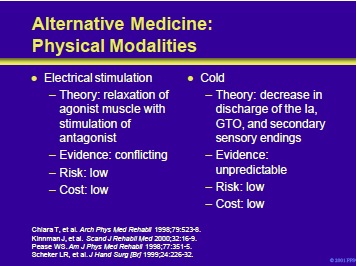
Electrical stimulation has been employed in the management of spasticity in patients with cerebral palsy and other disorders of the central nervous system. Physiologically, improvement in motor function might follow stimulation that triggered spastic muscles and inhibited antagonists.
The evidence for this approach is conflicting. In one study of a patient with spastic paraparesis who failed trials of physical therapy and baclofen, quantitative gait analysis demonstrated improvement following electrical stimulation of the quadriceps and anterior compartment musculature.
In a trial of 19 patients with spastic cerebral palsy, electrical stimulation of the antagonist extensors for 3 to 43 months, combined with dynamic bracing, dramatically decreased the manifestations of spasticity. The risks and costs of this intervention are low.
Topical cold may decrease reflex activity for short periods pres umably secondary to a decrease in neuronal discharges from different sources. However, the evidence for this approach is conflicting.
One study found statistically significant, but clinically irrelevant, changes in spasticity with a cooling suit. Another study found a weak, but significant, correlation between temperature decrements and reduction of central motor conduction. The risks and costs of this intervention are low.
Article Index
Page 3 of 9
Add comment